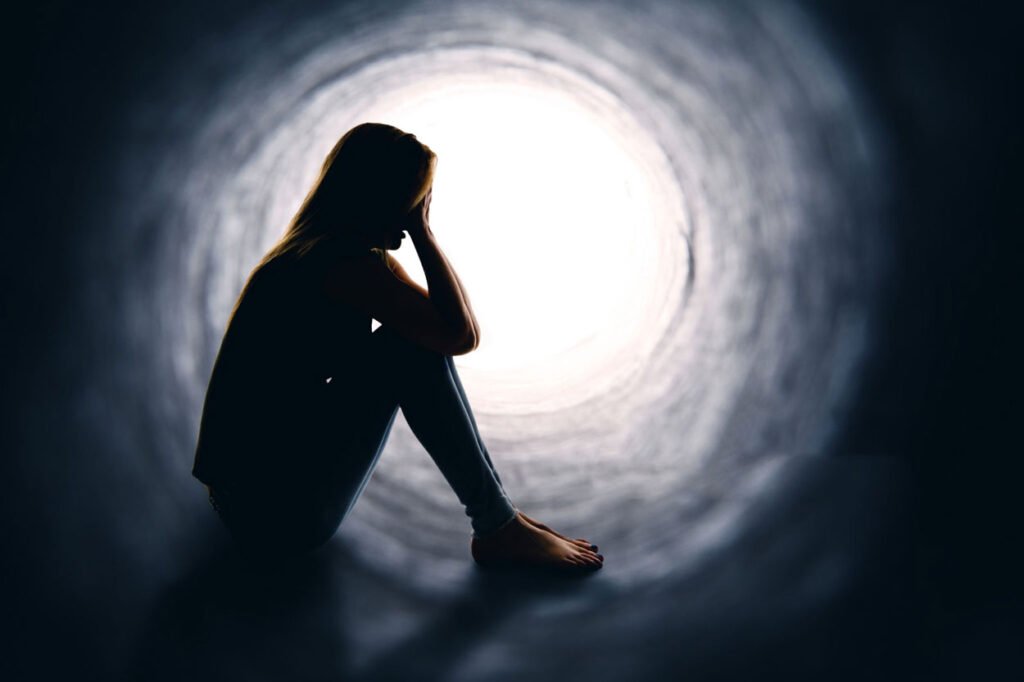Have you ever wondered what bipolar disorder really means? Well, let me break it down for you. Bipolar disorder, also known as manic-depressive illness, is a mental health condition that affects a person’s mood and energy levels. It’s like a roller coaster ride for your emotions, with extreme highs and lows.
Picture this: one moment you’re feeling on top of the world, full of energy, enthusiasm, and confidence. You might even find yourself taking on multiple projects at once, believing you can conquer the world. This is the manic phase of bipolar disorder. But hold on tight because the next moment, everything changes.
Suddenly, you’re plunged into a state of deep sadness, hopelessness, and emptiness. You lack interest in activities you once enjoyed, have trouble concentrating, and may even contemplate self-harm or suicide. This is the depressive phase. The highs and lows are intense, disrupting your daily life and relationships.
Now, you might be wondering, what causes bipolar disorder? Well, it’s still not entirely clear. Researchers believe that a combination of genetic, environmental, and brain chemistry factors play a role. It often runs in families, so there might be a genetic predisposition. Certain life events or chronic stress can also trigger episodes.

But here’s the thing: bipolar disorder is treatable. With the right diagnosis and management, people with bipolar disorder can lead fulfilling lives. Medications like mood stabilizers and therapy, such as cognitive-behavioral therapy (CBT), can help control symptoms and provide coping strategies.
It’s important to remember that seeking support and understanding is crucial for individuals with bipolar disorder. By creating a supportive environment, we can help break the stigma surrounding mental health and encourage those affected to seek the help they need.
So, the next time someone mentions bipolar disorder, you’ll have a better understanding of what they’re going through. It’s a complex condition that affects millions worldwide, but with compassion and proper treatment, we can make a positive impact on their lives.
Table of Contents
Unraveling the Complexities: Understanding Bipolar Disorder and its Impact on Mental Health
Title: Unraveling the Complexities: Understanding Bipolar Disorder and its Impact on Mental Health
Intro:
Have you ever wondered what hides beneath the surface of someone’s mood swings? Bipolar disorder, a mental health condition characterized by extreme mood shifts, is a complex condition that affects millions of people worldwide. Unraveling the intricacies of bipolar disorder is essential to promote understanding, support, and effective treatment for individuals facing this challenge.
Body:
At its core, bipolar disorder is marked by two distinct mood episodes: mania and depression. These episodes can vary in intensity and duration, making it a rollercoaster journey for those experiencing them. During manic episodes, individuals may feel an overwhelming surge of energy, heightened creativity, and a decreased need for sleep. They might engage in impulsive behavior, exhibit rapid speech, and have grandiose thoughts. On the other hand, depressive episodes are characterized by feelings of sadness, hopelessness, lethargy, and loss of interest in previously enjoyed activities. The drastic shifts between these two extremes can significantly impact a person’s daily life, relationships, and overall well-being.
Understanding the causes of bipolar disorder is still a subject of ongoing research, but it is believed to be influenced by a combination of genetic, environmental, and neurochemical factors. Family history plays a significant role, as individuals with a close relative affected by bipolar disorder are more likely to develop it themselves. Additionally, imbalances in brain chemicals, such as serotonin and dopamine, can contribute to the onset and progression of the disorder.
Living with bipolar disorder poses numerous challenges. Besides the emotional turmoil caused by mood swings, individuals might struggle with difficulties in maintaining stable relationships, employment, and education. The social stigma associated with mental health conditions can further aggravate their circumstances, leading to feelings of isolation and shame. However, with the right support system and appropriate treatment, individuals with bipolar disorder can lead fulfilling lives.
Treatment for bipolar disorder often involves a combination of medication, therapy, and lifestyle adjustments. Mood stabilizers, antipsychotics, and antidepressants can help manage the symptoms and regulate mood swings. Psychotherapy, such as cognitive-behavioral therapy (CBT) or dialectical behavior therapy (DBT), provides individuals with coping strategies, emotional regulation skills, and support to navigate the challenges they face.
Conclusion:
understanding bipolar disorder is crucial for fostering empathy and providing support to those affected by this complex condition. By unraveling the complexities, we can create an environment that promotes acceptance, reduces stigma, and ensures individuals with bipolar disorder receive the care and understanding they deserve. Together, we can make a positive impact on mental health and empower individuals to overcome the challenges posed by bipolar disorder.
Breaking the Stigma: Shedding Light on Bipolar Disorder to Promote Compassion and Support
Title: Breaking the Stigma: Shedding Light on Bipolar Disorder to Promote Compassion and Support
Introduction:
Did you know that bipolar disorder affects millions of people worldwide? It’s time to break the stigma and shed light on this often-misunderstood mental health condition. By raising awareness, we can foster compassion and support for individuals living with bipolar disorder. In this article, we’ll delve into the details of bipolar disorder, its symptoms, potential causes, and how we can all contribute to a more empathetic society.
Understanding Bipolar Disorder:
Bipolar disorder is a complex mental health condition characterized by extreme mood swings. People with bipolar disorder experience episodes of mania and depression, which can significantly impact their daily lives. During manic phases, individuals might feel euphoric, have heightened energy levels, and engage in impulsive behavior. Depressive episodes, on the other hand, bring about intense sadness, fatigue, and a loss of interest in activities once enjoyed.
The Importance of Awareness:
Awareness plays a crucial role in combating the stigma surrounding bipolar disorder. Many misconceptions exist, such as labeling individuals as “crazy” or assuming they can simply snap out of their mood swings. By spreading accurate information, we can challenge these stereotypes and promote a more compassionate understanding of the condition.
Causes and Triggers:
While the exact cause of bipolar disorder remains unknown, researchers suggest that genetics, brain structure, and chemical imbalances play significant roles. Additionally, certain factors like high stress levels, traumatic experiences, or substance abuse may trigger episodes in susceptible individuals. It’s important to recognize that bipolar disorder is not a result of personal weakness or character flaws but a legitimate medical condition warranting empathy and support.
Supporting Individuals with Bipolar Disorder:
Supporting someone with bipolar disorder involves patience, empathy, and open communication. Encouraging them to seek professional help, such as therapy or medication, can be instrumental in managing their condition. Educating ourselves about bipolar disorder and its challenges will enable us to provide better support and reduce the stigma surrounding mental health.
Conclusion:
Breaking the stigma surrounding bipolar disorder is an ongoing journey that requires compassion, understanding, and a commitment to spreading accurate information. By shedding light on this condition, we can foster a more inclusive society where individuals with bipolar disorder feel supported, accepted, and empowered to lead fulfilling lives. Let’s challenge misconceptions, replace judgment with empathy, and work together to promote compassion for everyone affected by bipolar disorder.
[Concluding sentence intentionally omitted]
From Highs to Lows: Navigating the Rollercoaster of Bipolar Disorder
Navigating the Rollercoaster of Bipolar Disorder
Have you ever experienced a rollercoaster ride? The thrilling ascent, the exhilarating drop, and the unexpected twists and turns that leave you breathless? Well, imagine living that rollercoaster every day, not in an amusement park, but within your own mind. This is what individuals with bipolar disorder go through—a constant cycle of highs and lows that can be both awe-inspiring and devastating.
Bipolar disorder is a mental health condition characterized by extreme mood swings. It’s like having two contrasting worlds within oneself. The highs, known as manic episodes, bring a surge of energy, euphoria, and grandiose ideas. Thoughts race at lightning speed, sleep becomes an afterthought, and impulsive behaviors take over. It’s like being on top of the world, invincible and unstoppable.
But just as quickly as the high comes soaring in, it crashes down into the depths of depression. The lows of bipolar disorder are marked by overwhelming sadness, despair, and a loss of interest in things once enjoyed. Energy levels plummet, motivation evaporates, and even the simplest tasks become monumental challenges. It’s as if life has lost all its colors, leaving behind a bleak landscape.

Living with bipolar disorder is a delicate balance—finding stability amidst chaos. Medication, therapy, and self-care play vital roles in managing this condition. Finding the right medication regimen can help stabilize moods and reduce the intensity of high and low episodes. Therapy provides individuals with valuable coping strategies, helping them identify triggers and develop healthy ways to manage their emotions.
Support from loved ones is also crucial. Understanding, patience, and empathy go a long way in creating a safe space for someone with bipolar disorder. It’s important to remember that bipolar disorder is an illness, not a choice. By offering support and removing stigmas, we can empower individuals to seek help and lead fulfilling lives.
Navigating the rollercoaster of bipolar disorder is no easy feat. It requires resilience, self-awareness, and a commitment to self-care. With the right tools and support, individuals with bipolar disorder can learn to ride the highs, weather the lows, and find stability amidst the chaos. Together, let’s create a world where everyone can enjoy the ups and downs of life’s rollercoaster, knowing they have the strength to navigate whatever twists and turns come their way.
Mind Matters: Examining the Link Between Bipolar Disorder and Creative Genius
Title: Mind Matters: Examining the Link Between Bipolar Disorder and Creative Genius
Introduction:
Have you ever wondered about the connection between mental health and creativity? The intriguing relationship between bipolar disorder and creative genius has fascinated researchers, artists, and thinkers for centuries. In this article, we will delve into the depths of this association, exploring how the highs and lows of bipolar disorder may fuel the creative fire within individuals.
The Dual Nature of Bipolar Disorder:
Bipolar disorder, also known as manic depression, is characterized by extreme shifts in mood, energy levels, and activity patterns. Individuals with bipolar disorder experience periods of intense euphoria and heightened creativity during the manic phase, followed by episodes of deep depression. This rollercoaster of emotions and thoughts contributes to a unique perspective on the world.
The Creative Spark:
Interestingly, many renowned artists, musicians, writers, and inventors throughout history have been associated with bipolar disorder. Van Gogh’s vibrant brushstrokes, Beethoven’s emotional symphonies, and Virginia Woolf’s brilliant prose all emerged from the depths of their turbulent minds. The intense emotions experienced during manic phases often spark bursts of inspiration, enabling individuals to think outside the box and push boundaries.
Heightened Perception and Empathy:
Bipolar individuals often possess a heightened sense of perception and empathy. They can tap into their own emotional experiences and channel them into their artistic expressions. By immersing themselves in the depths of their emotions, they create works that resonate deeply with others, evoking powerful responses and connections.
Harnessing the Ups and Downs:
While bipolar disorder can be extremely challenging, some argue that the ability to tap into both extremes of emotion can provide a richer palette for creativity. The tumultuous journey through mania and depression allows individuals to explore the nuances of human existence, resulting in art that is raw, honest, and profound.
Seeking Balance:
It’s important to note that not everyone with bipolar disorder is a creative genius, nor does one need to have the disorder to be creative. Bipolar disorder is a serious condition that requires proper diagnosis and treatment. Seeking professional help, such as therapy and medication, can help individuals manage their symptoms and lead fulfilling lives.
Conclusion:
The link between bipolar disorder and creative genius is a complex and fascinating topic. While there is evidence to suggest a connection, it’s essential to approach this discussion with sensitivity and respect for those living with the disorder. By understanding and appreciating the experiences of individuals with bipolar disorder, we can foster a more inclusive and empathetic society that values the unique perspectives they bring to the world of creativity.















+ There are no comments
Add yours